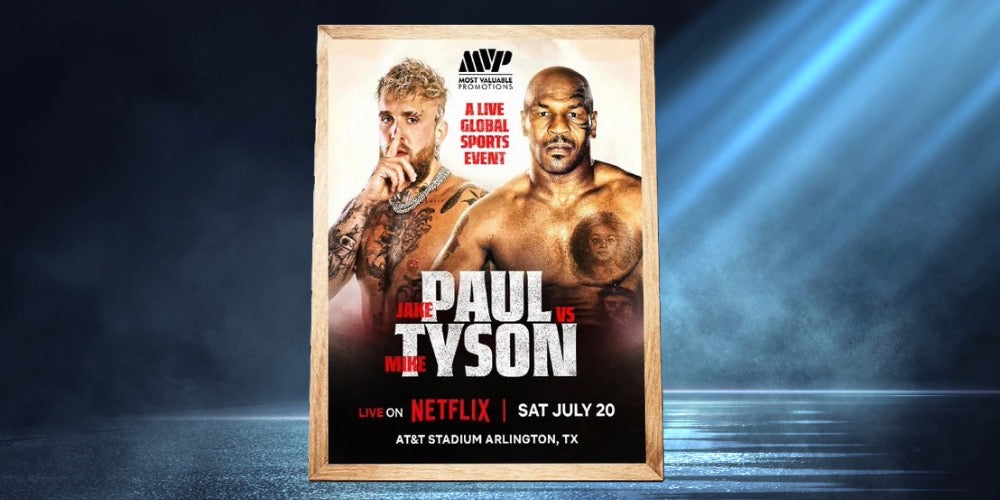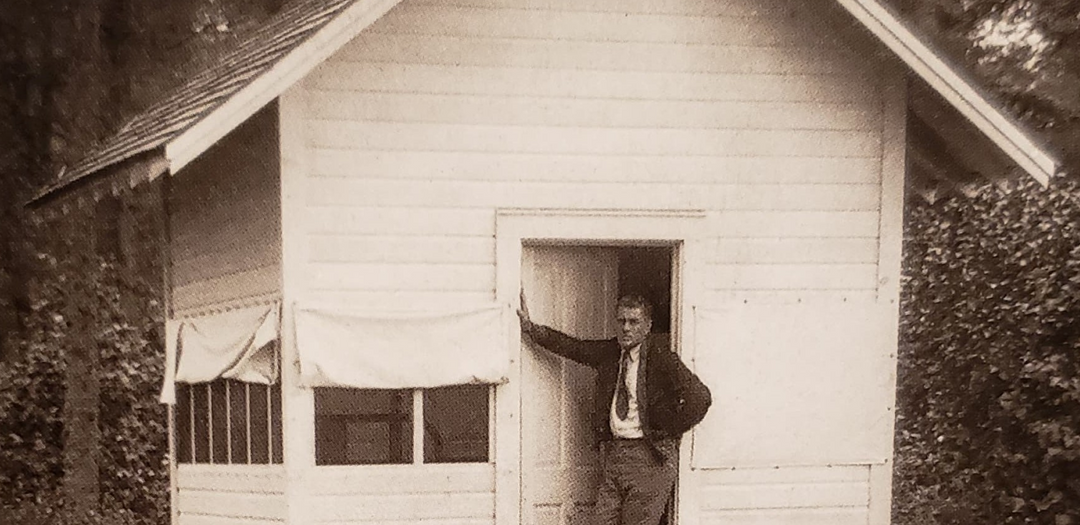Tunney arrived in Speculator on August 3, 1926 and was immediately followed by a plethora of media members. The restaurant area of the hotel became the makeshift press office and the sound of typewriters clacking day and night filled the building as they would report on Tunney’s every move during the training camp in order to promote the fight worldwide. Even though it was the height of Prohibition, there was a taproom in one of the hotels and the local sheriff did not enforce the law, thus Speculator became the hot spot for fight fans, and the press, wanting to come watch Tunney prepare for the championship. Both local fans from Fulton and Hamilton Counties, as well as the affluent fans from New York City, New Jersey and surrounding states started coming by train by way of Amsterdam, Fonda and Northville, as well as by car, bus and even amphibious planes which would splash down on Lake Pleasant and taxi up to the beach behind Osborne Hotel. Crowds of 2,000 people a day and upwards of 5,000 on the weekends would converge on Speculator. The busier the camp became, the more Tunney needed additional privacy to keep relaxed and focused. The Osbornes moved Tunney to a small camp secluded in the Pine Trees on their property. It was referred to as “the Shack” as it was about the size of a tool shed and had room enough for his bed, a desk and some reading material.
Most mornings, Tunney would do six to nine miles of roadwork on the remote Adirondack roads to build his wind and his legs. After breakfast, Tunney would retreat to his cabin and read books to pass the boredom of training camp. He was an autodidact, and liked to read the classics to help improve himself. Then afternoon training sessions took place which incorporated speed bag work, heavy bag work and sparring with other professional boxers who were brought into the camp. These fighters were often light-heavyweights who were smaller, but faster than typical heavyweights. He also specifically looked for fighters who had sparring or fighting experience against Dempsey. On days when he did not spar, former Hamilton County Sheriff and popular local Adirondack Guide, Frank “Pants” Lawrence, would take Tunney on long hikes deep into the surrounding Adirondack Mountains. After dinner each night, instead of the traditional fight camp activities of playing cards, drinking and chasing women, Tunney would canoe on the Kunjamuk River or take a walk along the shorelines of Lake Pleasant, before retiring to his cabin in the woods and listen to classical music.
One afternoon, an Associated Press reporter, Brian Bell, from New York City, was sent to interview Tunney for a story that was scheduled to be fed to newspapers across the United States and internationally. When the reporter could not find Tunney at the public areas of the hotel, he went looking for him at his secluded cabin in the woods. Tunney was out on a hike, and the reporter let himself into the cabin. Much to his surprise, he found the cabin stocked with classic reading materials. Tunney was not too pleased when he returned to find an uninvited stranger in his living quarters. As things were about to erupt, the writer asked him about the books in his cabin. Tunney’s mood was de-escalated and a discussion about his interest in classic literature ensued. When the reporter’s pre-fight story focused on Tunney’s hobby of reading and exposed him as an intellect, it shocked the fight world. Many saw it as a publicity stunt and not fathomable for a boxer. His reading became a big focus of the press, and rather than ask fight questions, members of the press began quizzing him on classic literature, trying to test his intellect. When word that Tunney was up in the woods reading books as part of his training, Dempsey and the rest of the fight world figured it was be an easy fight. Dempsey was considered unbeatable and after Tunney’s training regime was exposed, nobody gave the challenger a chance of winning and he was an 11-5 underdog.
While perplexed that he would be judged harshly for reading and bettering himself, he continued to employee his clean-living training regimen and enjoyed the serenity of his surroundings in Speculator as he had envisioned, with no distractions. He also became friends with and spent considerable time with local Franciscan Priest, Father John Murnane. Tunney believed that his connection to nature in Speculator was a religious one. His favorite saint was St. Francis, as he was associated with being the patron of animals and the natural environment. He also studied Dempsey’s style by watching films, interviewing former Dempsey opponents and developing defensive strategies to be ready for every move that Dempsey may bring at him in the fight. Learning that Dempsey was an aggressive striker, he also added a unique running strategy to his training by running up to an additional two miles per day backwards. This was to allow him to be able to move backwards as fluidly as he did forward, without losing his balance, should he get into trouble against Dempsey’s aggressive non-stop attacking style. And on his morning runs, he would stop along the way and shadow box, pretending that Dempsey was in front of him, envisioning the upcoming battle from each and every angle possible.
The newly built Sesquicentennial Municipal Stadium in Philadelphia, Pennsylvania was chosen as the fight site, and would serve to be part of America’s Sesquicentennial celebration of the founding of the United States in 1776. Two weeks prior to the September 23, 1926 fight, Tunney and his team left for Stroudsburg Pennsylvania to set up their final camp for the fight. This satisfied the event promoter, Tex Rickard, by putting him in closer proximity to the actual fight location and helped further promote ticket sales for the event. “Pants” Lawrence was now part of the Tunney team and made the trip with him. The event was tabbed as the “Manassa Mauler” vs the “Fighting Marine” and the two fighters both weighed in at 184 pounds and were almost identical in height and reach. Dempsey was a non-stop attacking puncher, and Gene was strategic, and worked to outpoint an opponent, rather than knock him out. The fight drew a record crowd of more than 120,000 tickets sold, which included politicians, millionaires, actors and many big-name athletes, both current and former. Extra trains brought boxing fans in from New York, New Jersey, Chicago and other points across the country. In addition to those in attendance, millions of others listened to the fight on the radio or watched telegraphic reports of the outcome. The total ticket gate for the fight was $1,895,000 and Dempsey was guaranteed $145,000 and 50% of everything over $1,000,000 of the total gate as the defending champion, while Tunney received a guarantee of $200,000 as the challenger. It was also estimated to have brought in an additional $3,000,000 in revenues to the city of Philadelphia, by way of meals, hotel rooms, train tickets and taxi fare. Dempsey was heavily favored to win the fight, which was scheduled for 10 rounds. Most of the press and sports world figured Dempsey would make quick work of the scholarly challenger and expected a knockout by Dempsey. Utilizing strategic responses to every move and punch that he thought Dempsey would throw, Tunney was able to out-maneuver Dempsey’s charges. Tunney out-boxed the champion through each and every round, going the full 10 rounds. Tunney won by decision to become the new Heavyweight Champion of the world, thus marking the first time a heavyweight championship was decided by a decision.

For the first few months in 1927, the new champion appeared in a Vaudeville act along the East Coast and West Coast. He also fought in several exhibition matches throughout the country. The following fall, a Tunney-Dempsey rematch was scheduled for September 22, 1927. It was tabbed “the Fight of the Century” and took take place at Soldiers Field in Chicago, Illinois. Tunney returned to Speculator to train for the fight, this time spending three months there. In addition to the stable of professional fighters he brought in to spar with him, he also brought in former Olympic Gold Medalists Eddie Eagan and Johnny Hayes to train with him. Eagan was a fellow boxer who also fought in the boxing tournaments during World War I in France and won a Boxing Gold Medal for the lightheavyweight division at the 1920 Summer Olympics in Antwerp Belgium. Eagan served as both a sparring partner and general confidant throughout the training camp. Hayes had won a gold medal in the marathon race at the 1908 Summer Olympics in London, England, and helped grow interest in long-distance running in the United States. His job was to help push Tunney to run longer distances for wind, leg strength, and to make sure he was ready to go the distance with Dempsey again.
Now as the new heavyweight world champion, the press and fight fans once again swarmed Speculator to watch Tunney train. Upwards to 5,000 fans would converge upon Speculator in a single day on the weekends, and the roadways into Speculator would be clogged with cars. A new ring was built on the other side of the road to allow for the larger crowds. While it had been free in 1926 to watch Tunney train as the challenger, the Osbornes started charging individuals 50 cents to watch the sessions. Tunney in turn donated those funds to local churches and the Speculator Winter Sports Club, which Osborne helped found in 1925 to promote winter sports in Lake Pleasant and Speculator. The St. James Church alone received over $10,000. Even the post office felt the effects of Tunney’s presence as mail arrived from all over the world addressed to him. It was too much to fit into his post-office box, so the postmaster began putting it in baskets, where Tunney’s secretary would pick them up each day and sort them out. The mail included autograph requests, solicitations for donations, advice on boxing and self-improvement, as well as marriage proposals.
Now weighing 189 pounds, Tunney continued to train as he had the previous summer, while once again reading classic literature and taking long hikes in the Adirondack Mountains during down time to relax himself. Knowing firsthand how hard it would be to knock out Dempsey, he trained to be ready for another fight that would last the full ten rounds. To do this, he utilized Hayes as his running trainer to beef up his roadwork and further improve his leg strength and wind. Hayes sometimes pushed their runs to make Tunney run as far as Wells, New York which was nearly fifteen miles away. And along the way he continued to stop to shadow box and also ran up to five miles worth of backwards-running. A few weeks ahead of the fight, Tunney moved his camp to Chicago, and this time both Lawrence and his friend Bill Osborne were part of the local team that joined Tunney and would be treated to front-row seats next to the ring.
The second fight sold 104,943 tickets and took in a total purse of $2,658,000. This marked the first $2,000,000 gate and the first fight to produce a $1,000,000 purse to one fighter. While the fight had been tabbed “the Fight of the Century”, a seventh round knock down of Tunney would leave the event forever remembered as “the Long Count.” Employing his unique strategies, Tunney was able to effectively outbox Dempsey through the first six rounds of the fight. But in the seventh round, Dempsey knocked Tunney to the canvas, marking the first time anyone had ever done this to Tunney in his previous 76 professional fights. Failing to immediately move to the neutral corner as stated under Illinois rules, Dempsey prevented the referee from starting the count. Some believe that this gave Tunney a few extra seconds to regain his composure and rise back to his feet ahead of the official ten-count. Upon the round continuing, Tunney drew from his exercises of running backwards on the dirt roads of Speculator to employ the strategy of being able to fluidly move backwards. This unique skill allowed him to effectively stay out of Dempsey’s reach and safely finish the round. By the start of the next round, Tunney had regained his composure and proceeded to knock Dempsey down in the eighth. Dempsey was also able to beat the ten count, and the fight went the full ten rounds. Having won nine of the ten rounds, Tunney was named the winner by unanimous decision by the judges and retained his title. Tunney’s share of the purse was $990,445.54 and was the highest purse ever paid to a single fighter in the pre-television era of the sport. Tunney gave promoter Tex Rickard $9,554.46 and Rickard in return cut him a check for an even $1,000,000 for the fight. According to Jay Tunney, “my Dad hung a copy of the check in our garage so he could be reminded of his triumph whenever he came home from work.”
Tunney always held to the belief that he would have beaten the normal count in his second fight with Dempsey. While it took forty years, Dempsey admitted that he also felt that Tunney would have beaten a normal ten count. The defeat led to the end of Dempsey’s career of fighting as a professional. He would go on to fight in exhibition matches up to 1940, and also ran a successful restaurant in New York City. The two fighters went on to become good friends and will forever be linked to what many experts consider to be the most storied championship fights in the history of the sport.







